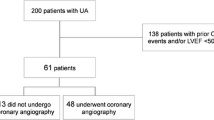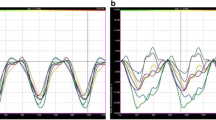Abstract
This study aimed to clarify the diagnostic and prognostic potential of strain rate in patients with suspected stable angina pectoris (SAP). Strain rate by 2-dimensional speckle tracking echocardiography (2DSTE) has been suggested to be able to diagnose coronary artery disease (CAD) and predict cardiovascular events in various patient groups. Prospectively enrolled patients (n = 296) with suspected SAP, no previous cardiac disease, and normal left ventricular ejection fraction were examined by 2DSTE, exercise ECG, and coronary angiography. Obstructive CAD was defined as stenosis ≥ 70% in ≥ 1 coronary artery on coronary angiography (n = 107). Major adverse cardiac events (MACE) included myocardial infarction, heart failure, atrial fibrillation, and stroke. In multivariable analysis adjusted for baseline data, conventional echocardiography, and Duke score, early diastolic strain rate (SRe) was independently associated with significant CAD with a 1.35 increased risk of having CAD per 0.1 decrease in SRe (OR = 1.35, 95% CI 1.03–1.76, P = 0.027). Peak velocity of early diastolic filling (E)/SRe was not associated with significant CAD (OR = 1.14, 95% CI 0.81–1.62, P = 0.445). MACE occurred in 34 patients (12%) during follow-up (median 3.5 years) and both SRe (HR 1.26, 95% CI (1.07–1.49), P = 0.006) and E/SRe (HR 1.24, 95% CI (1.04–1.47), P = 0.017) were independent predictors after multivariable adjustment. In patients with suspected SAP, SRe by 2DSTE was independently associated with presence of CAD. In addition, SRe and E/SRe provided independent and incremental prognostic value for predicting future MACE.




Similar content being viewed by others
References
Montalescot G, Sechtem U, Achenbach S et al (2013) 2013 ESC guidelines on the management of stable coronary artery disease. Eur Heart J 34:2949–3003. https://doi.org/10.1093/eurheartj/eht296
Biering-Sørensen T, Hoffmann S, Mogelvang R et al (2014) Myocardial strain analysis by 2-dimensional speckle tracking echocardiography improves diagnostics of coronary artery stenosis in stable angina pectoris. Circ Cardiovasc Imaging 7:58–65. https://doi.org/10.1161/CIRCIMAGING.113.000989
Liang HY, Cauduro S, Pellikka P et al (2006) Usefulness of two-dimensional speckle strain for evaluation of left ventricular diastolic deformation in patients with coronary artery disease. Am J Cardiol 98:1581–1586. https://doi.org/10.1016/j.amjcard.2006.07.038
Nucifora G, Schuijf JD, Delgado V et al (2010) Incremental value of subclinical left ventricular systolic dysfunction for the identification of patients with obstructive coronary artery disease. Am Heart J 159:148–157. https://doi.org/10.1016/j.ahj.2009.10.030
Ersbøll M, Andersen MJ, Valeur N et al (2014) Early diastolic strain rate in relation to systolic and diastolic function and prognosis in acute myocardial infarction: a two-dimensional speckle-tracking study. Eur Heart J 35:648–656. https://doi.org/10.1093/eurheartj/eht179
Ma H, Wu W-C, Xie R-A et al (2016) Correlation of global strain rate and left ventricular filling pressure in patients with coronary artery disease: a 2-D speckle-tracking study. Ultrasound Med Biol 42:413–420. https://doi.org/10.1016/j.ultrasmedbio.2015.09.022
Hoffmann S, Jensen JS, Iversen AZ et al (2012) Tissue Doppler echocardiography improves the diagnosis of coronary artery stenosis in stable angina pectoris. Eur Heart J Cardiovasc Imaging 13:724–729. https://doi.org/10.1093/ehjci/jes001
Pokharel P, Fujikura K, Bella JN (2015) Clinical applications and prognostic implications of strain and strain rate imaging. Expert Rev Cardiovasc Ther 13:853–866. https://doi.org/10.1586/14779072.2015.1056163
Chatzizisis YS, Murthy VL, Solomon SD (2013) Echocardiographic evaluation of coronary artery disease. Coron Artery Dis 24:613–623. https://doi.org/10.1097/MCA.0000000000000028
Brainin P, Hoffmann S, Fritz-Hansen T et al (2018) Usefulness of postsystolic shortening to diagnose coronary artery disease and predict future cardiovascular events in stable angina pectoris. J Am Soc Echocardiogr. https://doi.org/10.1016/j.echo.2018.05.007
Hagemann CA, Hoffmann S, Hagemann RA et al (2019) Usefulness of layer-specific strain in diagnosis of coronary artery disease in patients with stable angina pectoris. Int J Cardiovasc Imaging. https://doi.org/10.1007/s10554-019-01652-3
Lang RM, Bierig M, Devereux RB et al (2005) Recommendations for chamber quantification: a report from the American Society of Echocardiography’s guidelines and standards committee and the Chamber Quantification Writing Group, developed in conjunction with the European Association of Echocardiograph. J Am Soc Echocardiogr 18:1440–1463. https://doi.org/10.1016/j.echo.2005.10.005
Saunamäki K, Egstrup K, Krusell L et al (2002) Vejledende retningslinier for klinisk arbejdstest i relation til iskæmisk hjertesygdom (Dansk Cardiologisk Selskab). Cardiol Forum
Choi JO, Cho SW, Bin SY et al (2009) Longitudinal 2D strain at rest predicts the presence of left main and three vessel coronary artery disease in patients without regional wall motion abnormality. Eur J Echocardiogr. https://doi.org/10.1093/ejechocard/jep041
Shimoni S, Gendelman G, Ayzenberg O et al (2011) Differential effects of coronary artery stenosis on myocardial function: the value of myocardial strain analysis for the detection of coronary artery disease. J Am Soc Echocardiogr 24:748–757. https://doi.org/10.1016/j.echo.2011.03.007
Camici PG, Prasad SK, Rimoldi OE (2008) Stunning, hibernation, and assessment of myocardial viability. Circulation 117:103–114
Rumbinaite E, Zaliaduonyte-Peksiene D, Lapinskas T et al (2016) Early and late diastolic strain rate vs global longitudinal strain at rest and during dobutamine stress for the assessment of significant coronary artery stenosis in patients with a moderate and high probability of coronary artery disease. Echocardiography 33:1512–1522. https://doi.org/10.1111/echo.13282
Montgomery DE, Puthumana JJ, Fox JM, Ogunyankin KO (2012) Global longitudinal strain aids the detection of non-obstructive coronary artery disease in the resting echocardiogram. Eur Heart J Cardiovasc Imaging 13:579–587. https://doi.org/10.1093/ejechocard/jer282
Rostamzadeh A, Shojaeifard M, Rezaei Y, Dehghan K (2015) Diagnostic accuracy of myocardial deformation indices for detecting high risk coronary artery disease in patients without regional wall motion abnormality. Int J Clin Exp Med 8:9412–9420
Dalen H, Thorstensen A, Aase SA et al (2010) Segmental and global longitudinal strain and strain rate based on echocardiography of 1266 healthy individuals: the HUNT study in Norway. Eur J Echocardiogr 11:176–183. https://doi.org/10.1093/ejechocard/jep194
Voigt JU, Pedrizzetti G, Lysyansky P et al (2015) Definitions for a common standard for 2D speckle tracking echocardiography: consensus document of the EACVI/ASE/Industry Task Force to standardize deformation imaging. Eur Heart J Cardiovasc Imaging 16:1–11. https://doi.org/10.1093/ehjci/jeu184
Jespersen L, Hvelplund A, Abildstrøm SZ et al (2012) Stable angina pectoris with no obstructive coronary artery disease is associated with increased risks of major adverse cardiovascular events. Eur Heart J 33:734–744. https://doi.org/10.1093/eurheartj/ehr331
Stampehl MR, Mann DL, Nguyen JS et al (2015) Speckle strain echocardiography predicts outcome in patients with heart failure with both depressed and preserved left ventricular ejection fraction. Echocardiography 32:71–78. https://doi.org/10.1111/echo.12613
Antoni ML, Mollema SA, Delgado V et al (2010) Prognostic importance of strain and strain rate after acute myocardial infarction. Eur Heart J 31:1640–1647. https://doi.org/10.1093/eurheartj/ehq105
Acknowledgements
We would like to acknowledge Professor Jan Skov Jensens big contribution in conducting this study. It is with big sorrow that we had to say goodbye to our mentor and friend before publishing the results of the present report.
Funding
Tor Biering-Sørensen was supported by the Fondsbørsvekselerer Henry Hansen og Hustrus Hovedlegat 2016. The sponsors had no role in the study design, data collection, data analysis, data interpretation, or writing of the article.
Author information
Authors and Affiliations
Corresponding author
Ethics declarations
Conflict of interest
None.
Ethical approval
The study was approved by the regional Committee on Biomedical Research Ethics (J.No. H-C-2008-044) and was conducted according to the second Helsinki Declaration. All patients gave informed written consent.
Rights and permissions
About this article
Cite this article
Hagemann, R.A., Hoffmann, S., Brainin, P. et al. Early diastolic strain rate by two-dimensional speckle tracking echocardiography is a predictor of coronary artery disease and cardiovascular events in stable angina pectoris. Int J Cardiovasc Imaging 36, 1249–1260 (2020). https://doi.org/10.1007/s10554-020-01822-8
Received:
Accepted:
Published:
Issue Date:
DOI: https://doi.org/10.1007/s10554-020-01822-8




